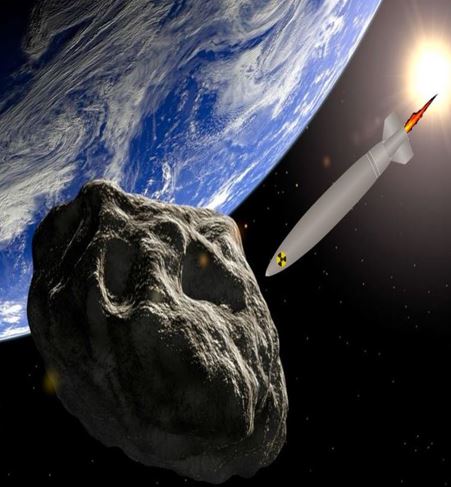Atomic bombs could be used to destroy killer asteroids that are heading our way and pose a threat to human life. This is what the European Commission is funding a group of eminent Russian engineers and scientists to investigate. The programme is called NEOShield (Near Earth Object Shield).
Impacts of near-Earth objects (NEOs) have contributed to mass extinctions and significant changes to the environment several times during our planet’s history, scientists say. NASA, ESA (European Space Agency) and Roscosmos (Russian Space Agency) say NEOs will continue hitting Earth at irregular intervals in the future.
One of these future impacts will be with a killer asteroid, i.e. catastrophic for human life – one of them could wipe us out completely. Nobody’s knows when the next big one will come – it could be in this decade, this century or not for hundreds or thousands of years (or even longer).
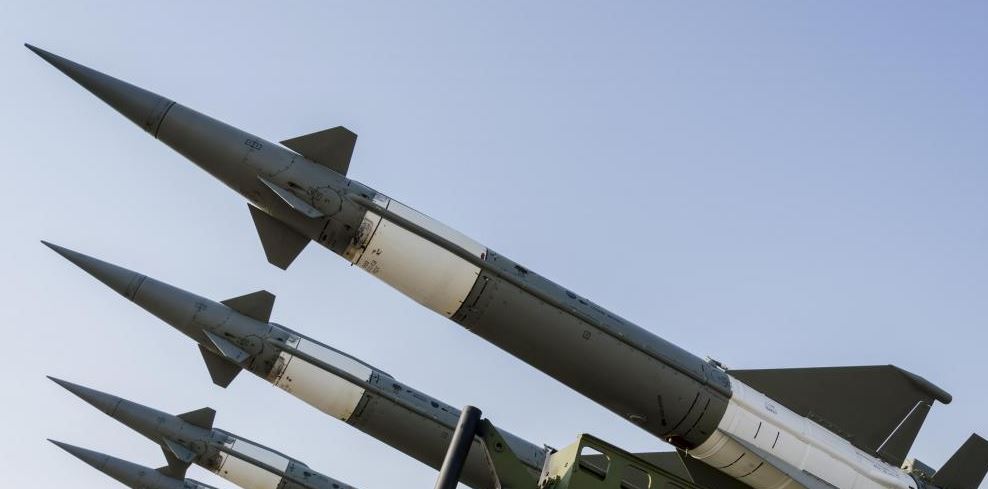 The scientists will try to determine how effective nuclear weapons would be in protecting us from an Earth-bound asteroid.
The scientists will try to determine how effective nuclear weapons would be in protecting us from an Earth-bound asteroid.
According to NASA:
“NEOShield is a new international consortium to address impact threats to Earth, and to organize, prepare and implement mitigation measures. The European Commission is providing a significant amount of funding to support the initiative.”
“The undertaking consists of research institutes, universities and industrial partners in Germany, France, the United Kingdom and Spain, as well as in the U.S. and Russia.”
Although stationing or firing nuclear weapons in outer space is illegal, according to the Outer Space Treaty of 1967, scientists believe the treaty could be immediately bypassed if our lives depended on it.
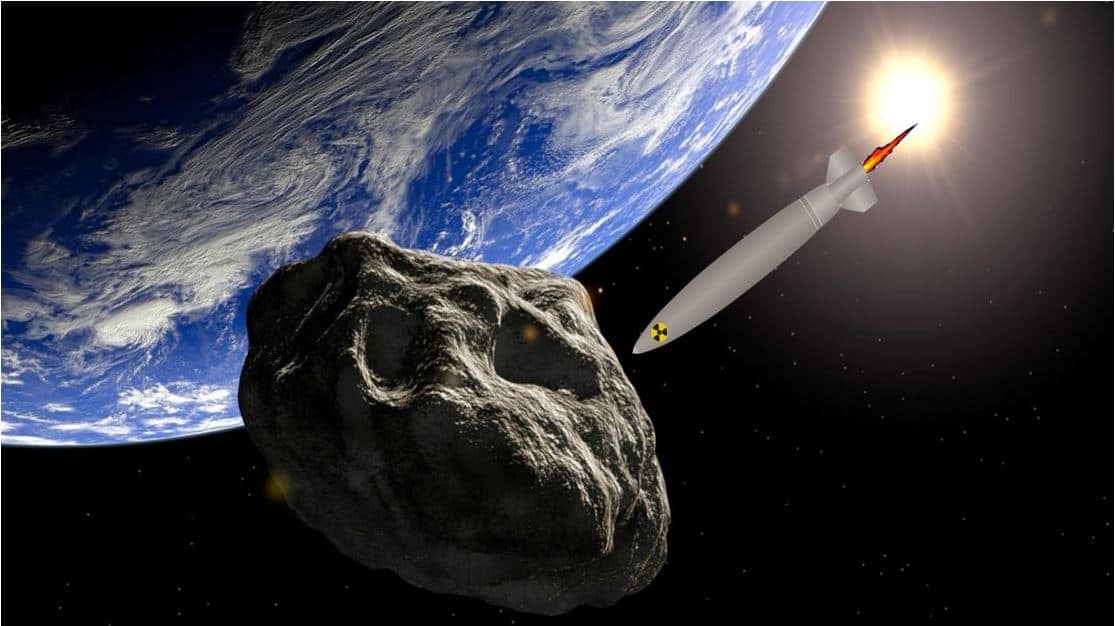 The European Commission and Russian scientists are collaborating on a project to use nuclear weapons to stop Earth-bound killer asteroids from crashing into our planet.
The European Commission and Russian scientists are collaborating on a project to use nuclear weapons to stop Earth-bound killer asteroids from crashing into our planet.
The plan would be to get an atomic bomb to explode on the Earth-bound asteroid which would have three possible effects:
1. It would be blown into lots of smaller chunks, which would not pose a threat to us any more (at least, not a global-scale threat).
2. The explosion would alter the mass of the asteroid (it would be smaller), which would change its trajectory, i.e. it would not crash into our planet.
3. Both consequences 1 and 2 would occur.
Nuclear weapons could protect us from killer asteroids, say Russian scientists
The Central Scientific Research Institute of Machine Building (TsNIImash), part of Roscosmos, Russia’s leading developer of space technology, said in a press statement:
“Work was distributed among various participants from different countries and organisations, and work on deflecting dangerous space objects with nuclear explosions was conducted by Russia.”
According to TsNIImash, nuclear weapons will have an important role to play in the future defense of Earth from dangerous NEOs, even if the current non-nuclear space treaty remains as it is. “If the asteroid threat becomes a matter of serious damage or even the very existence of life on Earth, that ban would naturally be lifted,” it added.
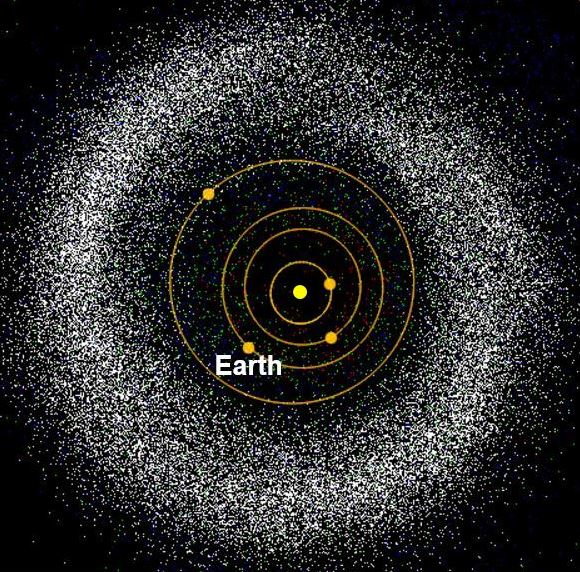 There are thousands of Near Earth Objects out there (blue, green and red dots). The white dots represent the main-belt asteroids. Brian Toon, from the University of Colorado, says a half-mile-wide asteroid hitting our planet would cause an explosion equal to 100 million tons of TNT. (Image: cosmosfrontier.com)
There are thousands of Near Earth Objects out there (blue, green and red dots). The white dots represent the main-belt asteroids. Brian Toon, from the University of Colorado, says a half-mile-wide asteroid hitting our planet would cause an explosion equal to 100 million tons of TNT. (Image: cosmosfrontier.com)
NASA sets up NEO defense team
In the United States, the National Aeronautics and Space Administration (NASA) set up an asteroid defense team earlier this month with the same objective – to prevent large NEOs from crashing into Earth.
In NASA’s case, rather than blowing up Earth-bound objects with nuclear weapons, the plan would be to get spaceships to shift the asteroid’s trajectory so that it goes in a different direction.
NASA’s Planetary Defense Coordination office will the tasked with finding and describing asteroids, as well as coordinating appropriate and effective defense responses to any that threaten to hit Earth.
NASA says its scientists know of 13,500 NEOs of all sizes, and is discovering 1,500 new ones each year.
Most NEOs are large
Over 90% of all the NEOs we know of are more than 1 kilometre (0.62 m) wide. NASA says it is concentrating on finding celestial objects at least 140 metres (450 ft) or larger.
Ten years ago, the US Government told NASA to locate 90% of this class of NEOs by the end of 2020. So far, it says it has detected approximately 25% of them.
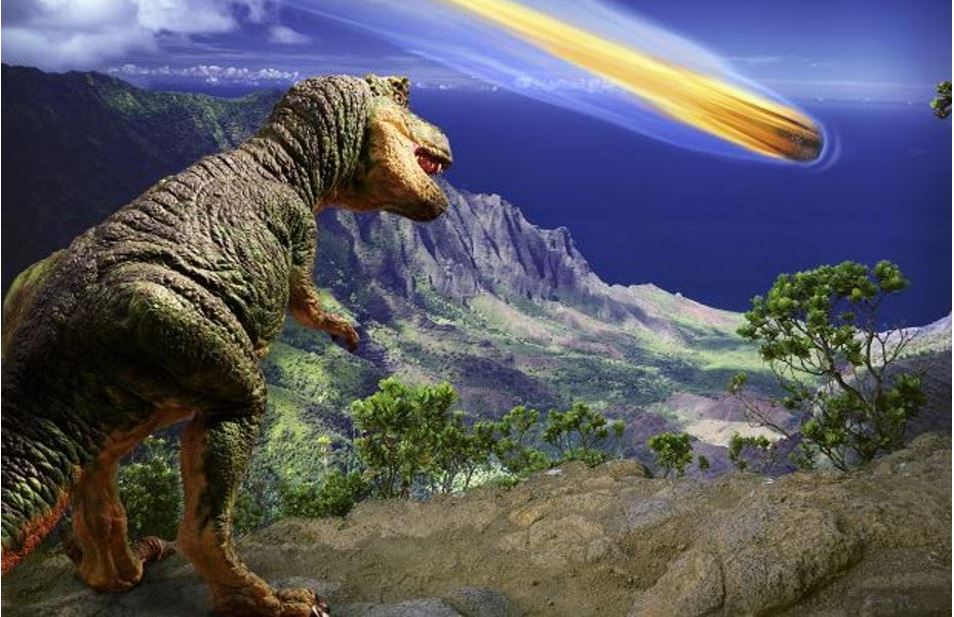 Little did this dinosaur know that the meteor he was looking at would wipe out his species.
Little did this dinosaur know that the meteor he was looking at would wipe out his species.
Associate administrator for NASA’s Science Mission Directorate in Washington, John Grunsfeld, said:
“Asteroid detection, tracking and defense of our planet is something that NASA, its interagency partners, and the global community take very seriously.”
“While there are no known impact threats at this time, the 2013 Chelyabinsk super-fireball and the recent ‘Halloween Asteroid’ close approach remind us of why we need to remain vigilant and keep our eyes to the sky.”
Protecting Earth from asteroids not a new idea
NASA says it has been involved in a worldwide plan for planetary defense for some time. However, it has now decided to step up its work and collaboration with other agencies, such as the Federal Emergency Management Agency (FEMA) to help organize an effective response to an asteroid impact and the possible disaster that would follow.
Program director in the agency’s Division of Astronomical Sciences, Nigel Sharp, said:
“NSF (National Science Foundation) welcomes the increased visibility afforded to this critical activity. We look forward to continuing the fruitful collaboration across the agencies to bring all of our resources – both ground-based and space-based – to the study of this important problem.”
Sending an asteroid rock into Moon orbit
NASA is developing a robotic mission which during the 2020s will visit a near-Earth asteroid, collect a large, multi-ton boulder, and take it towards the Moon, placing it in a Moon-orbit.
If that mission is successful, it would mean we had the technology required to drag an asteroid off its current course, i.e. deflect its trajectory so that it did not hit Earth.
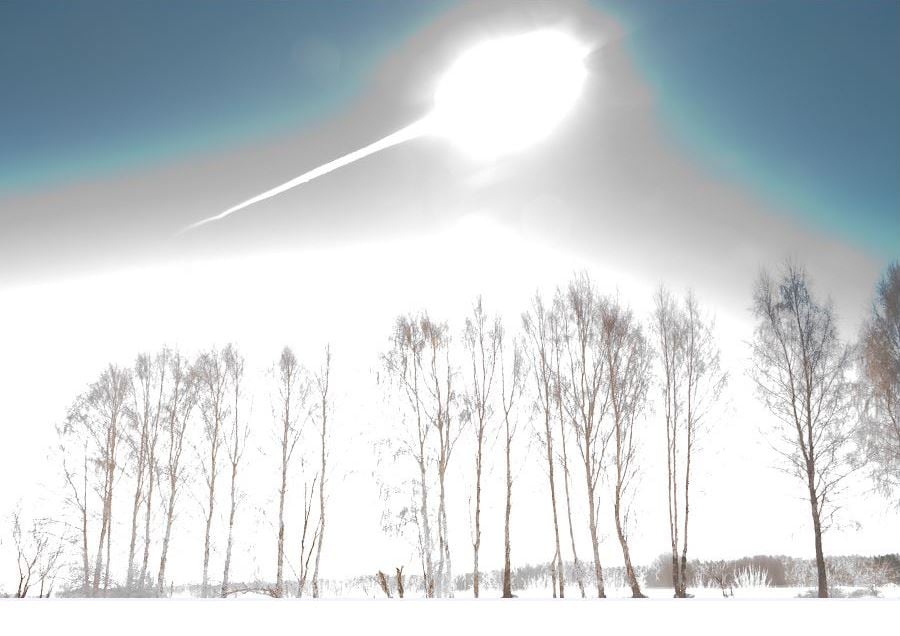 The Chelyabinsk meteor was just 17 metres wide, but caused damage to 7,000 buildings and injured nearly 1,500 people. Nobody knew it was coming. (Image: apod.nasa.gov)
The Chelyabinsk meteor was just 17 metres wide, but caused damage to 7,000 buildings and injured nearly 1,500 people. Nobody knew it was coming. (Image: apod.nasa.gov)
Sometimes we don’t see them coming
We also need to get better at spotting Earth-bound celestial objects. The Chelyabinsk meteor, which exploded at an altitude of 29.7 km (18.4 m) in Russia on 15th February, 2015, was a complete surprise – nobody saw that one coming. It came it at a speed of 60,000 to 69,000 km/h (40,000 to 42,900 mph).
The explosion generated a bright flash, a huge shock wave, and a hot cloud of dust and gas. Most of the blast’s energy – equivalent to 20-30 WWII Hiroshima atomic bombs – was absorbed by the atmosphere.
Even so, a total of 1,491 people were injured and 112 hospitalized. Property damage was extensive – Russian authorities said about 7,000 buildings were damaged. That meteor was tiny – just 17 metres wide.
What is the good of having super nuclear weapons that can blast asteroids into millions of little pieces if we are not very good at detecting the Earth-bound ones?
The asteroid that hit Earth near the Yucatan Peninsula in the Caribbean 65 million years ago, and was probably what cause the eventual extinction of the dinosaur, was just 6 miles (9.65 km) wide.
Wouldn’t it be tragic (even ironic) if we were destroyed by a large asteroid that could have been blasted out of the sky in time had those trillions of dollars we spent on the nuclear deterrent during the Cold War and afterwards been used for defending our planet?
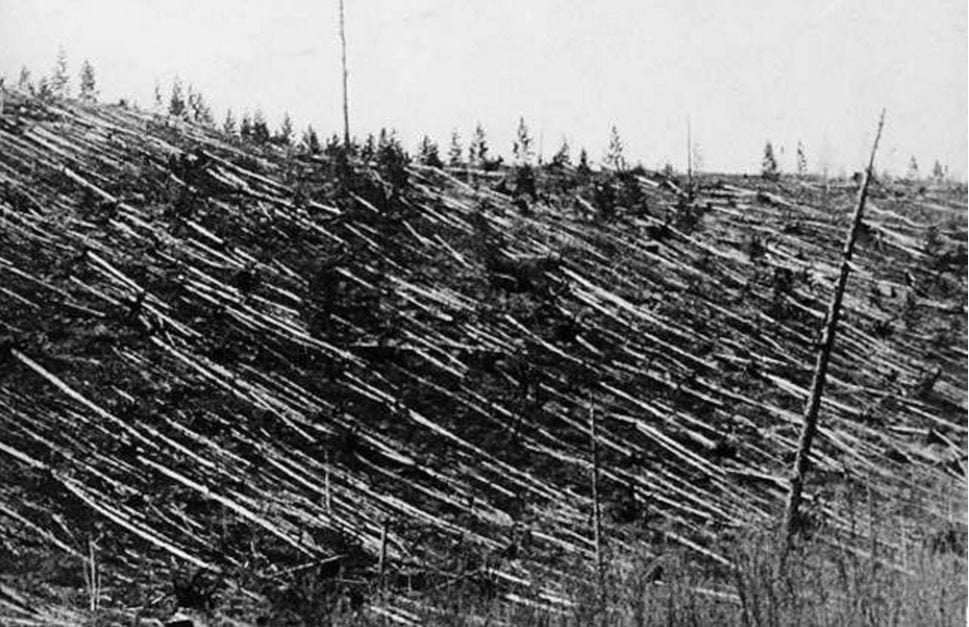 The Tunkuska Event: 770 sq miles of forest was completely flattened. If the explosion had occurred above a large city, it would have razed it to the ground. (Image: historyrundown.com)
The Tunkuska Event: 770 sq miles of forest was completely flattened. If the explosion had occurred above a large city, it would have razed it to the ground. (Image: historyrundown.com)
The Tunguska Event: this was a massive explosion, believed to have been caused by a meteor in 1908 near the Stony Tunguska River, a sparsely-populated region in Siberia. The blast flattened 770 square miles (2,000 km2) of forest. No casualties were reported.
The meteor is believed to have exploded from 5 to 10 km (3 to 6 miles) in the air. It had the force of about 1,000 Hiroshima bombs.
Several studies have estimated the object was between 60 and 190 metres (200 and 620 feet) wide. The Tunguska Event was the the largest impact event on Earth in ‘recorded’ history. Had the blast occurred above a major city, millions of people would have died – it would have flattened the whole of London.
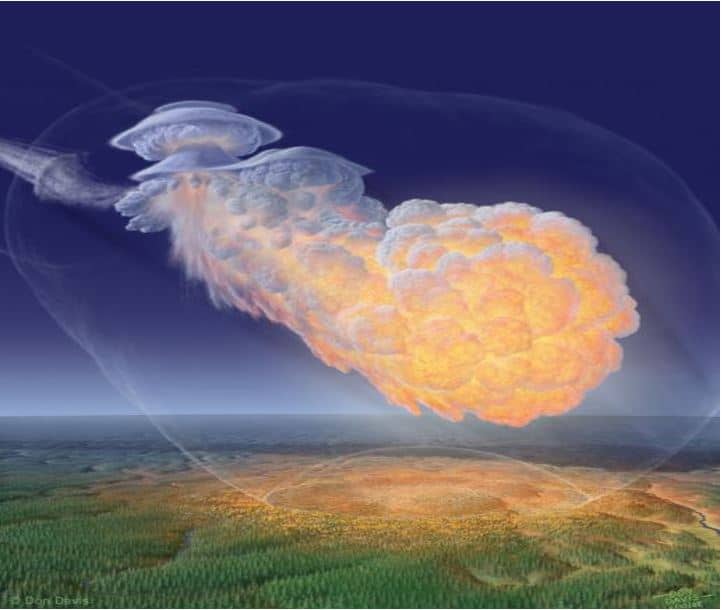 An artist’s visualisation of the Tunkuska blast and shockwave. (Image: historyrundown.com)
An artist’s visualisation of the Tunkuska blast and shockwave. (Image: historyrundown.com)
History Rundown quotes farmer Sergei Semenov, one of the few people who witnessed the Tunguska event. Mr. Semenov said:
“I was sitting in the porch of the house at the trading station of Vanovara at 7 a.m. and looking towards the north … suddenly the sky appeared like it was split in two, high above the forest, the whole northern sky appeared to be completely covered with blazing fire.”
“At that moment I felt a great wave of heat as if my shirt had caught fire… after a minute, there was a loud bang in the sky, and I could hear a mighty crash. Subsequently, I was fiercely thrown to the ground about 5-6 meters away from the house and for a minute or two I lost my consciousness.”
Video – The threat of killer asteroids
The threat of killer asteroids, unlike the weather, volcanoes or earthquakes, are potentially catastrophic events that we can do something about.

